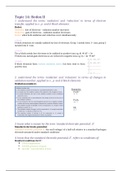Topic 14: Redox II
1. understand the terms ‘oxidation’ and ‘reduction’ in terms of electron
transfer, applied to s-, p- and d-block elements
Redox
Oxidation: loss of electrons – oxidation number increases
Reduction: gain of electrons – oxidation number decreases
Redox: when both oxidation and reduction occur simultaneously
s-block
S-block elements are usually oxidised by loss of electrons. Group 1 metals form 1+ ions, group 2
metals form 2+ ions.
p-block
The p-block metals lose electrons to be oxidised to positive ions e.g. Al Al3+ + 3e-
P-block non-metals gain electrons so are reduced to negative ions e.g. O 2 + 4e- 2O2-
d-block
D-block elements form various oxidation states, but they tend to form
positive ions
2. understand the terms ‘oxidation’ and ‘reduction’ in terms of changes in
oxidation number, applied to s-, p- and d-block elements
Oxidation numbers
Examples:
Cr2O72-
+6 -2
Fe3O4
+8/3 -2
OF2
+2 -1
3. know what is meant by the term ‘standard electrode potential’, E˚
Standard electrode potential
Standard electrode potential E˚: the emf (voltage) of a half-cell relative to a standard hydrogen
electrode measured under standard conditions
4. know that the standard electrode potential, E˚, refers to conditions of:
Standard conditions for E˚:
298 K temperature
100 kPa pressure of gases
mol dm-3 concentration of ions





